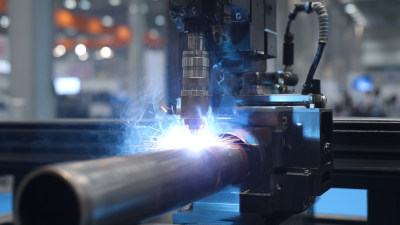In the realm of aerosol technology, the spray can nozzle serves as a crucial component that determines the efficiency and effectiveness of the product delivery system. According to a recent report from Smith Research Group, the global spray can market is projected to exceed $9 billion by 2025, driven by the rising demand for convenient packaging solutions across various industries, including cosmetics, household products, and automotive care. The design and functionality of the spray can nozzle significantly influence user experience, product performance, and environmental sustainability.

Dr. Emily Chen, an industry expert and author of "Aerosol Technology and Applications", emphasizes the importance of nozzle design by stating, "The spray can nozzle is not just a physical connector; it is the heart of the product's delivery system, influencing not only the spray pattern but also the dispersion rate and overall effectiveness." This statement underlines how intricate advancements in nozzle technology are shaping the future landscape of aerosol applications.
As manufacturers continue to innovate, understanding the mechanics and variations of spray can nozzles becomes imperative for optimizing product delivery and meeting consumer expectations. This article delves into the workings of spray can nozzles, examining their designs, functionalities, and implications for effective application across various sectors.
 A spray can nozzle is a crucial component that determines how effectively the contents of the can are dispensed. Essentially, the nozzle transforms the liquid inside into a fine mist or spray, allowing for uniform coverage and finer application. This is achieved through a combination of mechanical engineering and fluid dynamics, where the design of the nozzle controls the pressure and flow of the liquid. The shape and size of the nozzle opening can be tailored to create different spray patterns, from focused jets to wide dispersals, catering to various applications such as painting, cleaning, or personal care.
A spray can nozzle is a crucial component that determines how effectively the contents of the can are dispensed. Essentially, the nozzle transforms the liquid inside into a fine mist or spray, allowing for uniform coverage and finer application. This is achieved through a combination of mechanical engineering and fluid dynamics, where the design of the nozzle controls the pressure and flow of the liquid. The shape and size of the nozzle opening can be tailored to create different spray patterns, from focused jets to wide dispersals, catering to various applications such as painting, cleaning, or personal care.
Understanding the functionality of spray can nozzles involves examining the intricacies of how they interact with the propellant and the product. When the nozzle is pressed, it allows the pressurized propellant to force the liquid up through the tube and out of the opening, atomizing it in the process. This atomization is key to achieving an even spray that reduces overspray and waste. Additionally, some nozzles are designed with adjustable features, enabling users to modify the spray pattern and intensity, making them versatile for different tasks. This comprehensive overview of spray can nozzles highlights their importance in achieving effective and efficient application across various industries.
The significance of spray patterns in various industries cannot be overstated, as they directly impact the effectiveness of applications across multiple sectors. Different nozzle designs create specific spray patterns, which can be tailored to achieve desired results in tasks ranging from agriculture to cleaning. For instance, wide fan spray patterns are ideal for covering large areas quickly, while narrow spray patterns allow for precise applications in difficult-to-reach locations. This versatility makes spray can nozzles essential tools in sectors such as pest control, where targeted application is critical for effective pest management.
Moreover, the global spray nozzle market reflects this importance, with a projected growth from $291.9 million in 2023 to $403.1 million by 2031. This upward trend highlights the increasing demand for efficient spraying solutions in industries like pest control, where the market is anticipated to grow significantly from $15.86 billion in 2023 to more than $26 billion in the next decade. As industries evolve and seek more effective methods for application, the role of spray can nozzles and their diverse spray patterns will continue to be pivotal in meeting these needs.
The efficacy of a spray can nozzle is largely determined by its performance metrics, which assess the efficiency of product dispersion. Key factors influencing nozzle performance include spray pattern, droplet size, and the range of coverage. A well-designed nozzle should create a consistent and uniform spray pattern, ensuring that the product is evenly distributed across the target surface. This uniformity not only enhances the application’s visual appeal but also maximizes the effectiveness of the product, minimizing waste.

Droplet size is another critical performance metric, as it directly affects the adhesion and absorption of the sprayed material. Smaller droplets tend to evaporate quickly, which can lead to uneven application, while larger droplets may result in a heavier application that could cause drips or runs. An ideal nozzle strikes a balance, producing droplets that optimize the interaction with surfaces without compromising the intended usage.
Additionally, the nozzle's range of coverage plays a vital role in user convenience and efficiency; a nozzle that allows for adjustable spray patterns can cater to different application needs, enhancing overall performance.
Spray can nozzles have undergone significant innovations in recent years, dramatically enhancing user experience and efficiency. One notable advancement is the development of adjustable nozzles that allow users to customize the spray pattern and flow rate. According to a recent industry report, customizable spray patterns can increase application efficiency by up to 30%, as users can tailor the spray to suit different surfaces and projects. This innovation not only improves the precision of the application but also reduces material waste, a key factor in sustainable practices within the industry.
Furthermore, ergonomic designs of spray nozzles have been introduced, significantly improving comfort and reducing hand fatigue during extended use. A report by the American Coatings Association indicates that over 60% of consumers prefer products with user-friendly designs, which suggests a growing market demand for more ergonomic solutions. To maximize the benefits of these innovations, users should consider practicing proper technique: hold the can at a consistent distance from the surface, and maintain a steady motion for even application.
**Tips:** Always test the spray on a scrap surface to determine the best distance and angle for optimal results. Clean the nozzle after each use to prevent clogs and ensure smooth operation for the next application.
Spray can nozzles are integral components designed not only for efficient application but also for adherence to industry standards and regulations that ensure safety. These standards often dictate the materials used in nozzle construction, the design specifications for spray patterns, and the control mechanisms that govern flow rates. Compliance with such regulations is crucial as it minimizes risks associated with inhalation of harmful vapors and ensures that the spray is delivered accurately and effectively.
Moreover, regulations often emphasize the importance of labeling and user instructions, which are essential for promoting safe practices during application. Industry bodies frequently update these standards to incorporate advances in technology and improvements in chemical formulations, further enhancing safety and effectiveness. Manufacturers must regularly test their products to confirm that they meet these evolving standards, reflecting a commitment not only to performance but also to public health and environmental protection. By aligning with these regulations, manufacturers can create spray can nozzles that provide users with a reliable and safe application experience.






